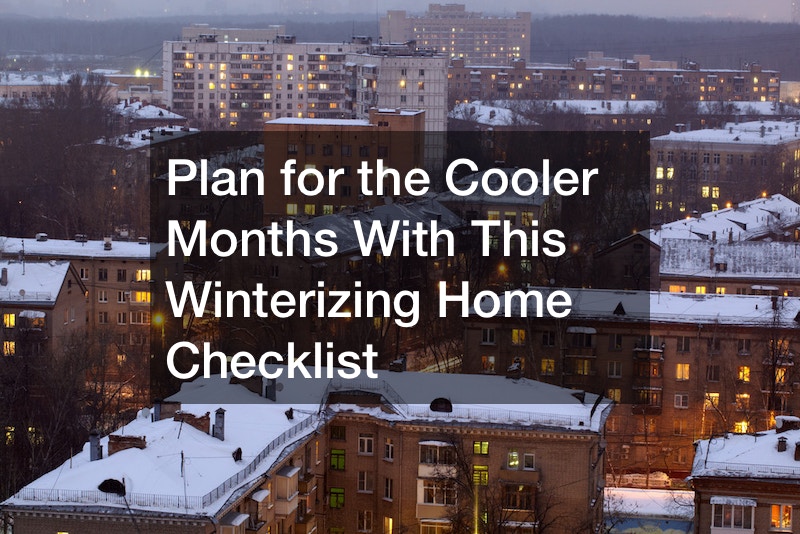As the temperatures start dropping, and the days grow shorter, it tells you that the cold season is around the corner – and it’s time to prepare your home for the cooler months ahead. Snow, ice, or plummeting temperatures can wreak havoc on your home if it’s not properly winterized, resulting in discomfort, potential damage, and bigger energy bills. To ensure your home is ready to face winter’s chill, create a cozy haven with our comprehensive winterizing home checklist.
1. Inspect and Seal Windows and Doors
When preparing your home for winter, one of the first things you should do is look closely at your windows and doors, especially the mostly overlooked garage doors. Inspect them carefully for cracks, gaps, or worn-out weatherstripping, and call for a garage door repair professional.
These small openings might not seem like a big deal, but they can pass in chilly drafts and let the warm air escape. They make your home less cozy and energy-efficient. To tackle this, seal any air leaks using caulk that you can apply along stationary places like window frames.
Weatherstripping using various forms like adhesive-backed foam tape or door sweeps can do the trick for movable parts like the bottom of doors or sashes. After you’re done, testing for any lingering drafts is a good idea. Wondering how? Simply light a candle and hold it near the edges of the windows and doors on a windy day.
If the flame flickers, there’s your draft. Identify the source and apply extra caulk or weatherstripping as needed. Remember, some cracks may be so complex that you’ll need the services of a general home repair company to work on the big cracks that may damage the house structure.
Taking these steps early on is an important part of your winterizing home checklist that will keep those pesky drafts at bay and make your home more energy-efficient throughout the winter season.

2. Insulate the Attic
The next thing in the winterizing home checklist should make you turn your attention to the attic. Insulating your home’s attic is essential to maintaining a warm environment. With the help of a technician, you should examine the current insulation in your attic. If it appears worn out, adding more insulation to enhance its effectiveness is worth it.
A well-insulated attic is a protective barrier that prevents valuable heat (one that you truly need during winter)from escaping through the roof and ensuring it stays inside your living spaces where you need it most. In addition to bolstering the existing insulation, take a moment to keenly inspect and insulate any access points leading to the attic, including attic doors or hatches.
Properly insulated access points create a tight seal that helps maintain a consistent temperature in your house. This also helps to reduce drafts and potential energy waste.Before the cold season arrives–and it waits for no one, check your attic and repair it to effectively fortify your home against the intrusion of cold air and the loss of valuable warmth.
You’ll be reducing the need for excessive heating and hence energy bills. Don’t overlook the importance of insulating your attic—it’s a smart and rewarding investment in your home’s long-term efficiency and comfort.
3. Insulate Walls and Crawl Spaces
Now, let’s move on to the third point of your winterizing home checklist, which involves insulating your home’s walls and crawl spaces. Proper insulation in these areas starts by assessing the insulation in your home’s exterior walls. If you find it insufficient, adding insulation to improve energy efficiency is advisable.
Depending on your wall’s construction, you can choose a suitable insulation method and material from different types of insulation, such as fiberglass batts, foam board insulation, or blown-in insulation. Consulting a professional or researching the best insulation services company will help you a lot in your home’s specific needs and climate.
While working on your home’s exterior, pay attention to any crawl spaces beneath your home. Insulating them creates a thermal barrier between the ground and your living spaces, preventing chilly air from seeping in. Use insulating materials like rigid or spray foam to effectively insulate the crawl space.
However, if you are not a professional or you aren’t working with an expert insulating professional, ensure you understand the manufacturer’s instructions and safety guidelines to contribute to a more comfortable indoor environment.
Maybe you’ve already ruled out heat losses via the AC by doing AC repairs, but have you checked the other potential culprit for potential heating loss– the poorly insulated areas in your house? If not, don’t wait for the winter season to insulate your home’s walls and crawl. It’s time to do it.

4. Service the Heating System
Imagine the surprise of a water cold shower in the morning during winter due to malfunction, all because you ignored inspecting your water heating system early on! Terrible! As you tick the completed task on your winterizing home checklist, focus on the condition of your plumbing system, in this case, the part that heats your dishwasher, water, and showers.
Inspecting and maintaining your water heater unit is essential for ensuring optimal performance and efficiency during the winter season. It’s a good idea to schedule a professional heating unit inspection and maintenance service where a qualified technician can thoroughly assess the system, clean or replace damaged filters, check for any potential causes of malfunctions, and do necessary repairs or adjustments.
Regular maintenance helps improve the system’s efficiency, extends its lifespan, and reduces the risk of unexpected breakdowns, especially during the cold months. Aside from professional servicing, you can also regularly replace air filters. For instance, clogged filters restrict airflow, making your system work harder and less efficiently.
Check the manufacturer’s recommendations for filter replacement frequency and ensure you have an adequate supply of clean filters. Also, maintain cleanliness around the system and remove any debris, dust, or flammable materials that may have accumulated near the unit. This promotes proper airflow and reduces the risk of fire hazards.
Remember to familiarize yourself with the system’s operating manual. You’ll know the importance of servicing your system and keeping it in optimal condition at the right time to enjoy a warm and comfortable home throughout the winter while maximizing energy efficiency.
5. Check and Insulate Pipes
The next crucial point to consider on your winterizing home checklist is ensuring the proper functioning of your plumbing system and septic tank. Taking proactive measures in this regard will help you ensure a smooth and hassle-free winter season. However, scheduling a professional plumbing service to inspect your plumbing system is advisable.
A skilled plumber will check for any leaks, detect potential pipe vulnerabilities, and address any other existing or may arise plumbing issues. They should also guide how to prevent frozen pipes during winter, which can lead to costly water damage. Addressing plumbing concerns beforehand will mitigate emergency risks as you maintain a reliable water supply throughout the winter.
As part of your plumbing repairs, hire a professional septic tank technician to inspect any issues with your septic tank. Paying attention to your septic tank and regularly maintaining it by scheduling a septic tank service ensures proper functioning and prevents any backups or overflows during the winter.
Furthermore, it’s advisable to take preventative measures like insulating exposed pipes in unheated areas of your home, including basements, crawl spaces, or attics. This insulation, mentioned in our winterizing home checklist, will protect the pipes from freezing temperatures, preventing them from bursting.
Prioritizing plumbing services and septic tank maintenance from reliable companies is a proactive approach that provides peace of mind throughout the winter. Remember to disconnect and drain outdoor hoses, shut off exterior faucets, and consider insulating outdoor spigots for a smooth winter months.

6. Inspect the Roof and Do the Needed Repairs
Your winterizing home checklist cannot be complete without considering the important task of inspecting your roof– the first line of defense against the elements. It’s crucial to ensure the roof is in good condition before the winter weather sets in.
Conduct a thorough inspection with the help of the best locally available company that offers roofing services. Look for missing shingles that could lead to leaks or water infiltration during winter’s heavy rainfall or snowfall.
The professional roofing technicians can repair or replace damaged shingles, fix any leaks, reinforce vulnerable areas and recommend the best roofing materials if you are looking for a new roof. While inspecting the roof, take note of the areas around chimneys or vents where the flashing, seals, or caulking may be compromised.
Consult an expert roofer to properly seal these vulnerable areas. Additionally, clear away any debris that may have accumulated on the roof to avoid the problem of blocked gutters and downspouts, which can lead to water buildup, especially due to melting ice and potential damage.
Clean the roof and gutters to ensure proper drainage and prevent ice dams from forming during freezing temperatures. Finally, inspecting and maintaining your roof safeguards your home from potential water damage, guaranteeing your home’s structural integrity during the winter season.
7. Engage a Tree Care Service Provider
Have you added the tree maintenance task and the next point to your winterizing home checklist? If not, it’s important to consider the care and maintenance of your trees. Trees contribute to the beauty of your property, provide shade, and ensure wind protection and overall environmental health.
Ensure you trim the existing ones and plant more windbreakers to safeguard your home from the strong winter winds. After that, engage the expertise of an arborist to ensure the proper tree care, promoting their well-being during the winter season.
These tree services agents identify potential issues like diseased or damaged branches, signs of pests, or structural weaknesses and recommend the appropriate treatments or pruning techniques to address these issues before winter comes and worsens them.
8. Ensure Proper HVAC Functionality
Taking care of your HVAC system is essential for maintaining an energy-efficient home during winter. Prioritizing HVAC repairs beforehand ensures optimal performance and avoids potential issues, such as failure, that may arise when you need the most heat from your system.
To ensure your system will provide the warmth your home deserves during winter, schedule a professional HVAC maintenance service to have a qualified technician inspect and tune up your system. They’ll clean the components, check for worn-out parts, and perform necessary adjustments or replacements to maximize efficiency.
However, ensuring regular maintenance throughout the year helps you to address minor issues before they escalate into major problems, ensuring your HVAC system operates smoothly during the cold months. Winter. You can also clear any obstructions around vents or registers to ensure unrestricted air circulation.
Telling whether your HVAC system needs repair, especially if you have not considered maintaining it before, may be challenging. However, there are tell-tale signs that, once you notice them, don’t delay contacting a reputable HVAC inspector. The signs include strange noises, insufficient heating, or uneven airflow.
Skilled technicians can diagnose and resolve HVAC issues promptly, preventing further damage. Remember, proper HVAC functionality contributes greatly to energy savings while ensuring a cozy home throughout the winter.

9. Ensure Accessibility of Snow Tools and Maintain Emergency Backup Systems
Winter may wreak havoc in your home, especially if you aren’t fully prepared with suitable snow tools, or you don’t have their accessibility. As the cold weather starts to set in, ensure the shovels, snow blowers, and ice melt are easily accessible by organizing and storing them conveniently on your garage storage shelves.
Check the tool’s condition and replace any damaged or worn-out tools. Do not forget to purchase a supply of de-icing agents to prevent slippery surfaces that can cause serious injuries during winter. Imagine falling and injuring yourself when it’s that cold! Prepare thoroughly to avoid this.
Regarding emergency backup systems, regularly maintain and test generators or battery-powered inverters to ensure they are ready for use during power outages– which occur frequently during winter. Check fuel levels, oil, and batteries, and follow manufacturer guidelines for maintenance.
Conduct periodic tests to confirm their proper functioning before winter comes. If any issues arise, seek professional assistance. Such preparedness will ensure you efficiently manage snow removal while maintaining an essential power supply during these adverse weather conditions.
Winterizing your home ensures a safe, comfortable, and efficient living environment during the colder months. Following this comprehensive winterizing home checklist will guide you to proactively address the key areas of concern and protect your home from the harsh effects of winter, reduce energy consumption, and enhance the overall comfort and security of your living space.





